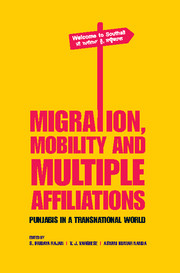Book contents
- Frontmatter
- Contents
- List of Tables and Figures
- Preface
- Acknowledgements
- Transnational World and Indian Punjab: Contemporary Issues
- Part I A Historical Survey
- 1 Punjabis in America
- 2 Punjabi–Sikh Migration: Latin America – A Geographic Profile
- 3 Punjabis/Sikhs in Canada
- 4 Punjabi Migration, Settlement and Experience in the UK
- Part II Shifting Contours of Migration
- Part III Social Structures and Organizational Links
- Part IV Education and Migration
- Part V Family Networks
- Contributors
- Index
1 - Punjabis in America
from Part I - A Historical Survey
Published online by Cambridge University Press: 05 March 2016
- Frontmatter
- Contents
- List of Tables and Figures
- Preface
- Acknowledgements
- Transnational World and Indian Punjab: Contemporary Issues
- Part I A Historical Survey
- 1 Punjabis in America
- 2 Punjabi–Sikh Migration: Latin America – A Geographic Profile
- 3 Punjabis/Sikhs in Canada
- 4 Punjabi Migration, Settlement and Experience in the UK
- Part II Shifting Contours of Migration
- Part III Social Structures and Organizational Links
- Part IV Education and Migration
- Part V Family Networks
- Contributors
- Index
Summary
Introduction
The first significant movement of Punjabis to North America from their ancestral homeland in Punjab province on the northwest Indian plains of South Asia began at the turn of the twentieth century. It has continued, with some profoundly restrictive early periods, to the present.
Before 1900, allusions to South Asian presence in North America are sporadic and fragmentary. The earliest verified account appears to be that found in the colonial diary of William Bentley (1962), who in 1790 met a ‘Madrasi’ in the company of a ship's captain. Probably a lascar (Indian seaman) and from Dravidian South India, the Madrasi's stay was a brief one.
The first individual Sikh in North America appears to have been an aide or servant to a Captain Phillips in eighteenth century Salem, Massachusetts. This individual reportedly also drove the Phillips family to church on Sundays (Essex Institute Historical Collections, 1940; Phillips, 1947). Other ‘East Indian’ sailors frequented Eastern US ports as part of the British-American sea trade. Half a dozen took part in a Fourth of July celebration in Salem, Massachusetts in 1851 (Whitehill, n.d.). Other brief mentions of early South Asians in America include stories of Hindus in the gold fields of California in 1852 and 1855 (Gerstacker, 1942; Winkley, 1957) as well as reports of Indian merchants visiting New York and San Francisco for commercial purposes from the 1850s onward.
Overall, the arrival of Punjabis on the west coast of North America occurred relatively late in terms of the larger patterns of outmigration history for all peoples then residing within the British Empire. From the 1880s onward, South Asians traveled to East and South Africa, the Caribbean, East and Southeast Asia, Western Europe and the South Pacific. By the early 1900s, Canada and the United States were but two of many destinations in a worldwide diaspora (Cumpston, 1953; Kondapi, 1951; Singh, 1966; Barrier and Dusenbery, 1989).
Although all migrations are in some ways similar, the characteristics of the earliest South Asian arrivals in both Canada and the US were quite unusual. The first Punjabi immigrants to North America were almost exclusively males from Punjab province of then British India. 85 to 90 per cent of them were self-identified as Sikhs, 10 to 12 per cent Punjabi Muslims, with the remainder being Punjabi Hindus.
- Type
- Chapter
- Information
- Migration, Mobility and Multiple AffiliationsPunjabis in a Transnational World, pp. 39 - 67Publisher: Cambridge University PressPrint publication year: 2015
- 1
- Cited by



